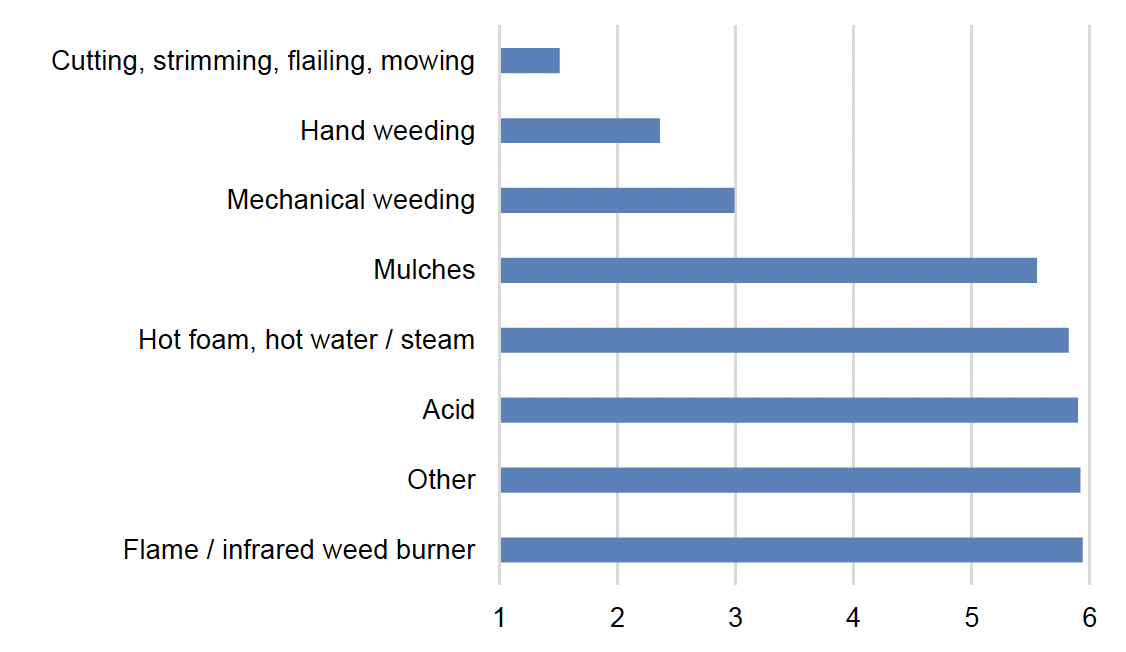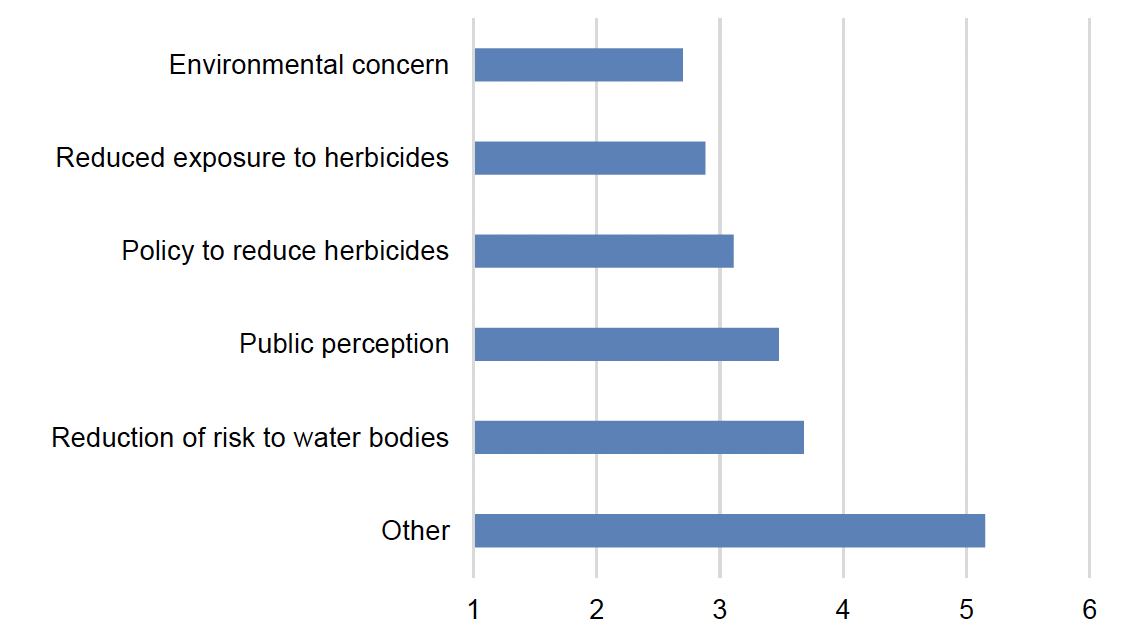Pesticide Usage in Scotland: Local Authority Integrated Weed Control Survey - 2019
This publication presents information from a survey of weed control strategies used by Local Authorities in Scotland during 2019
This document is part of a collection
Integrated weed control strategies
Qualitative data on weed control attitudes and strategies was received from 28 LAs representing 89 per cent of Scottish land area and 93 per cent of the Scottish population. As described previously, it must be noted that two LAs provided partial data, with their response relating to weed management in greenspaces only. In addition, one LA provided three separate responses from different departments which were amalgamated, for further information on survey methodology please refer to Appendix 5.
Integrated weed management (IWM) is a weed management program based on a combination of preventative, cultural, mechanical and chemical practices. Therefore, control programmes incorporate non-herbicide methods alongside, or instead of, herbicide control. As part of an IWM approach, use of herbicides should be as targeted as possible. To gain a greater understanding of IWM techniques used in the amenity sector, LAs were asked a series of questions related to their awareness of IWM and their weed control practices.
Integrated weed management awareness and policy
LAs were asked about membership of industry associations or schemes that promote integrated weed control. Fourteen per cent were members of the Amenity Forum. The Amenity Forum is the UK's industry led voluntary initiative, promoting best practice and the safe and sustainable management of weeds, pests and diseases across the amenity sector(2). No LAs were members of Amenity Assured or the Property Care Association (PCA) Invasive Weed Code. These schemes ensure amenity contractors are recognised and qualified to offer professional pesticide services and advice to the amenity sector. However, 57 per cent of the LAs (16) were aware of the new UK Amenity Standard which was launched in February 2020. Ten of these LAs stated that they will require their own personnel, or those responsible for weed control on their behalf to be compliant with the UK Amenity Standard. The UK Amenity Standard is a quality management benchmark, to ensure that public spaces are maintained to the highest professional levels, seeking to keep all amenity areas safe and healthy for all to use(3).
All 28 local authorities who responded stated that they used non-herbicide methods of weed control. However, only one LA had a formal policy about the integrated control of weeds. No LA had a formal Integrated Weed Management plan although one was in the process of producing one.
Seventeen LAs (61 per cent) stated that they were aware of the Defra Best Practice Guidance(4) for integrated and non-chemical amenity hard surface weed control. This guidance was produced by Defra in 2015, primarily for LAs, to help minimise pesticide use in public spaces, to protect the environment, reduce pesticide resistance and improve public perception. A further 10 stated that they were aware of the Amenity Forum Integrated Weed Management Guidance and Template for creating an Integrated Weed Management Plan.
Overall, local authority awareness and adoption of IWM practices is high. All participating LAs adopted integrated methods of control, although most were yet to develop a formal policy or adopt a formal IWM plan. This is likely to improve as more LAs comply with the new Amenity Standard in future.
Adoption of integrated weed management practices
Twenty seven of the LAs (96 per cent of respondents) stated that they used weed prevention methods to reduce the need for subsequent weed control, which is a central principle of IWM (Table 1). The most commonly used method was mulching, used by 26 LAs (93 per cent), followed by replacing annual flower beds with perennial beds to reduce maintenance input requirements (22 LAs, 79 per cent). Other methods included identifying or mapping of priority areas to target control effort (10 LAs, 36 per cent) and resurfacing of public areas such as replacing slabs with asphalt to reduce the need for weed control (nine LAs, 32 per cent). Three LAs (11 per cent) also reported improving drainage/soil aeration as a method of weed prevention.
Local Authorities were provided with a list of non-herbicide approaches to weed control and asked to indicate the options used by them, or by a contractor on their behalf, during 2019. They were also asked to rank the methods in relation to which are the most commonly used. Please see Appendix 5 Survey methodology for a description of the statistical methods used. Weed control by cutting, strimming, flailing or mowing was most commonly used, followed by hand weeding and then mechanical weeding such as weed brushing or ripping (Figure 2, Table 2). All other methods were used less frequently. No LAs reported using electrocution, grazing or biological control to control weeds.

"Other" included creation of wildflower areas to reduce the need for weed control. No LAs reported using electrocution, grazing or biological control to control weeds.
Please note for the rank, the lower the number the more commonly the method is used. Please see Appendix 5 Survey methodology for a description of statistical methods used.
As well as adopting non-chemical control measures, 21 local authorities (75% of respondents) stated that they assessed how effective these control measures had been. Review of effectiveness is also a central principle of IWM.
Where non-herbicide methods of control were used by LAs, they were asked to rank the main reasons for their use. Mean ranking of reasons for using non-herbicide control methods are presented in Figure 3 and Table 3. The reasons ranked as most important were; concern about the environmental risk of herbicide use and to reduce operator and public exposure to herbicides. Public perception of spraying herbicides and reduction of risk to water bodies were both (on average) rated as less important by respondents. The category rated least important was where herbicide control was not possible and hand weeding was the only option, e.g. in shrub beds where herbicide use would damage ornamental planting (it should be noted that this was recorded under the "Other" category by a single respondent).

"Other" included where herbicide control was not possible and hand weeding was the only option, e.g. in shrub beds where herbicide use would damage ornamental planting.
Please note for the rank, the lower the number the more important the reason. Please see Appendix 5 Survey methodology for a description of statistical methods used.
Contact
Email: psu@sasa.gov.scot
There is a problem
Thanks for your feedback